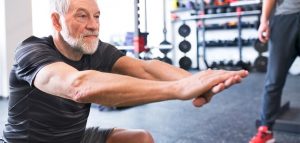For older adults, resistance training is a widely recognized strategy to maintain or improve muscle strength and function which consequently leads to an improved quality of life. Without it, our ability to perform physical tasks becomes difficult as we age and affects our quality of life. The role of muscle strength (the ability for the muscles to generate maximal force) has been proven by numerous studies to be indicative of function in older adults, where decreased strength results in a reduction in functional performance.
Whilst muscle strength has shown to be a strong determinant of functional limitations in older adults, research has now shown that muscle power declines earlier and faster than muscle strength as we age and is now being recognised as a crucial predictor of functional limitations in older adults. This can be for a variety of reasons, such as a decline in muscle mass, changes in muscle composition, strength and reduced neuromuscular function that is associated with age. As muscle power declines at up to twice the rate than muscle strength, it is important to incorporate power type exercises to prevent this and optimise an individual’s function.
Muscle power is the maximal force exerted in as short as time as possible (typically seen in jumping, punching, kicking etc) – it is a product of force and velocity. To improve muscle power, we can either train the velocity or the force component through exercise. In an exercise setting, we can train this by completing resistance-based exercises at high movement speeds (in an explosive manner). This can be done at low intensities or high intensities, but it depends on different types of functional tasks people encounter during every day. The research has found that for most older adults, we are more likely to encounter tasks that require low resistances such as sit to stands, going up and downstairs, transferring in and out of bed etc. So, completing exercises at low intensities but at high velocities will provide the most benefit for our day-to-day function. Here we are training the velocity component of power, and as we learn how to develop and produce force at a faster rate, this improves our ability to complete a variety of day-to-day tasks.
Power training provides a wide range of other benefits, such as increased rate of force production (a strong indicator of function), increased muscle strength and neural adaptations such as increased neural input to the working muscles. Consequently, this optimises older individual’s performances for their activities of daily living and thus plays an important role in preserving function and quality of life for older adults. If you are interested in this type of training, please discuss this with an Exercise Physiologist who can develop safe and effective exercises for you.




